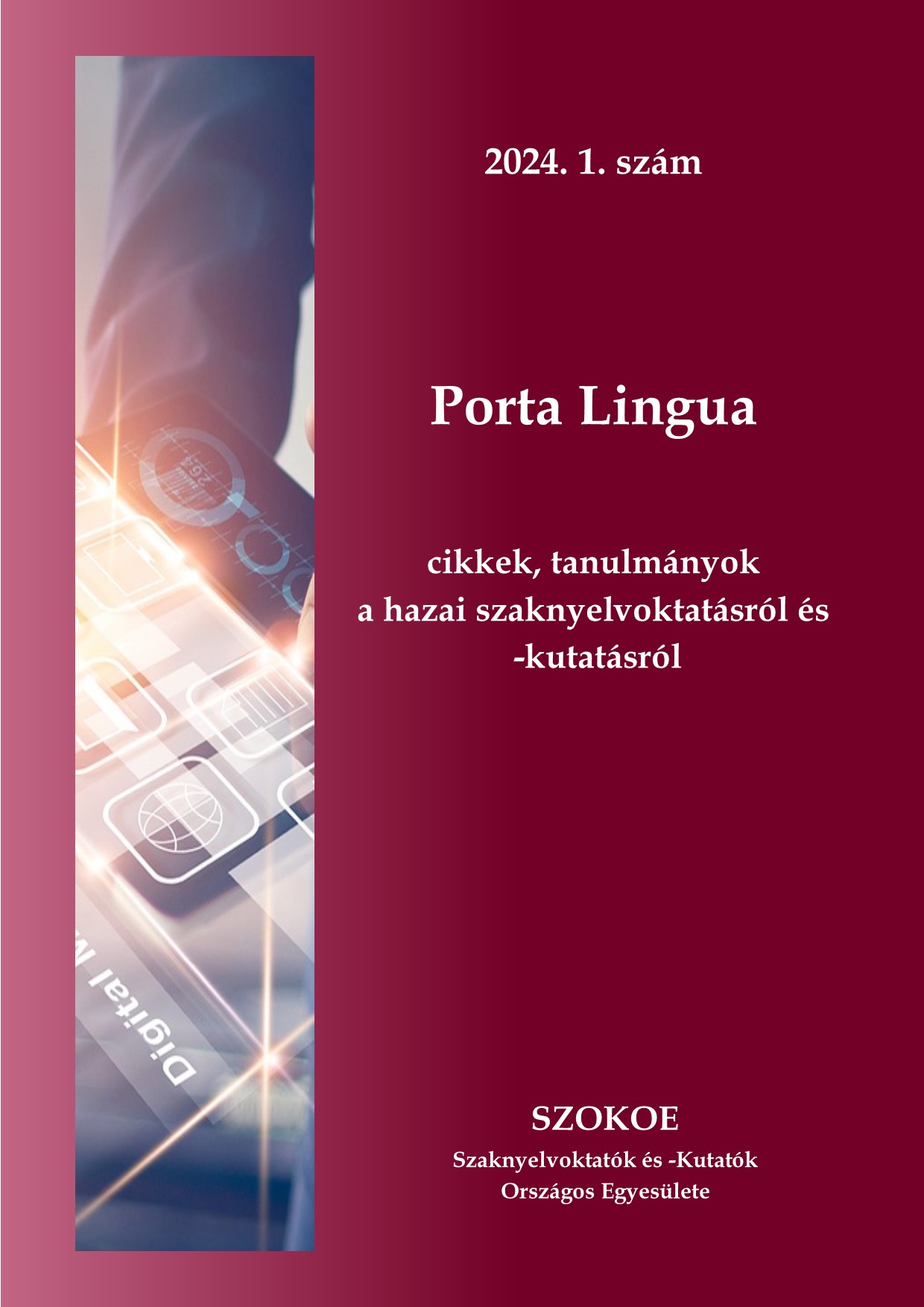A lexikai egyszerűsítés összehasonlító elemzése magyarról angolra fordított és tolmácsolt szövegeken
Absztrakt
Although research on translation and interpreting activities have different focuses, the importance of corpus linguistics in both disciplines has been highlighted over the last few decades. Nonetheless, relatively few intermodal corpora, including written and spoken texts and their (simultaneously) interpreted and translated counterparts, have been devised. The development of the EPTIC corpus was started by Bernardini et al. (2016) to fill this gap in the field of Corpus Linguistics. In the scope of their research, a multilingual intermodal corpus was built including the original speeches of European Parliamentary sessions in 2011, their verbatim (written) reports, the translations of the source language texts as well as the simultaneously interpreted texts. The aim of the EPTIC project is to examine and compare lexical simplification (Laviosa, 1998a, 1998b), in translated and interpreted texts in different language pairs and directions. In a similar vein, I aim to explore whether the texts interpreted in Hungarian–English directions are lexically simpler than the translated ones through the analysis of a bilingual intermodal sub-corpus.
Hivatkozások
Baker, M. (1995): Corpora in Translation Studies. An Overview and suggestions for Future Research. Target. 7/2. 223‒245. https://doi.org/10.1075/target.7.2.03bak
Baker, M. (1993): Corpus Linguistics and Translation Studies. Implications and Applications. In: Baker, M. – Francis, G. – Tognini-Bonelli, E. (eds.) (1993): Text and Technology: In honour of John Sinclair. 233250. Amsterdam: John Benjamins. https://doi.org/10.1075/z.64.15bak
Bakti, M. (2010): Disharmonies in the target language output of simultaneous interpreters. Unpublished PhD dissertation, Eötvös Loránd University. Online elérhető: https://doktori.btk.elte.hu/lingv/baktimaria/thesis.pdf
Bakti, M. – Kusztor, M. (2017): Speech errors in simultaneously interpreted German target language texts. A descriptive analysis. Alkalmazott Nyelvtudomány. 17/2. 1–17. Online elérhető: http://alkalmazottnyelvtudomany.hu/wordpress/wp-content/uploads/bakti.pdf
Bernardini, S. – Ferraresi, A. – Petrovic, M. M. (2016): From EPIC to EPTIC — Exploring simplification in interpreting and translation from an intermodal perspective. Target. 28/1. 61–86. https://doi.org/10.1075/target.28.1.03ber
Bernardini, S. – Ferraresi, A. – Russo, M. – Collard, C. – Defrancq, B. (2018): Building Interpreting and Intermodal Corpora: A How-to for a Formidable Task. In: Russo, M. – Bendazzoli, C. – Defrancq, B. (eds.) (2018): Making Way in Corpus-based Interpreting Studies. 21–41. Springer: Singapore. https://doi.org/10.1007/978-981-10-6199-8_2
Chesterman, A. (2004): Hypotheses about Translation Universals. In: Hansen, G. – Malmkjær, K. – Gile, D. (eds.) (2004): Claims, Changes and Challenges in Translation Studies: Selected Contributions from the EST Congress, Copenhagen 2001. 1–13. Benjamins Translation Library. https://doi.org/10.1075/btl.50.02che
Defrancq, B. – Plevoets, K. – Magnifico, C. (2015): Connective items in interpreting and translation: Where do they come from? In: Yearbook of corpus linguistics and pragmatics. 195–222. Springer: Cham. https://doi.org/10.1007/978-3-319-17948-3_9
Ferraresi, A. – Bernardini, S. – Petrović, M. – Lefer, M.A. (2018): Simplified or not simplified? The different guises of mediated English at the European Parliament. Meta. 63/3. 717–738. https://doi.org/10.7202/1060170ar
Gabrielatos, C. (2018): Keyness Analysis: nature, metrics and techniques. In: Taylor, C. – Marchi, A. (eds.) (2018): Corpus Approaches to Discourse: A critical review. 225–258. Oxford: Routledge. Online elérhető: https://www.academia.edu/34302240/Gabrielatos_C_2018_Keyness_Analysis_nature_metrics_and_techniques_In_Taylor_C_and_Marchi_A_eds_Corpus_Approaches_to_Discourse_A_critical_review_Oxford_ Routledge_225_258
Gile, D. (2001): Consecutive vs. simultaneous: Which is more accurate? Interpretation Studies. 1/1. 8–20. https://doi.org/10.50837/istk.0103
Heltai, P. (2002): “Claims, Changes and Challenges”. EST 3rd Congress in Copenhagen. 30 August–1 September 2001. Fordítástudomány. 4/1. 123–133.
Heltai, P. (2021): Hungarian–English Constrastive Linguistic Studies. L’Harmattan: Budapest.
Kajzer-Wietrzny, M. (2012): Interpreting universals and interpreting style. Unpublished PhD dissertation. Adam Mickiewicz University, Poznań, Poland. Online elérhető: https://www.academia.edu/2440862/Interpreting_Universals_and_Interpreting_Style_doctoral_dissertatio n
Kovács, T. (2020a): Interferenciajelenségek összehasonlító vizsgálata nem fordított magyar és angolról magyarra fordított jogi szaknyelvi szövegekben (A comparative study of linguistic interference phenomena in non-translated Hungarian and English- Hungarian translated legal texts). In: Szabóné Papp, J. (ed) (2020): Alkalmazott Nyelvészeti Közlemények, Interdiszciplináris tanulmányok. Publications of the University of Miskolc. 13/2. 150–165. Miskolc: Miskolci Egyetemi Kiadó. Online elérhető: https://matarka.hu/koz/ISSN_1788-9979/vol_13_no_2_2018/ISSN_1788-9979_vol_13_no_2_2018_150164.pdf
Kovács, T. (2020b): Korpusznyelvészet és tolmácsolás (Corpus Linguistics and Interpreting). In: Adorján, M. – Kovács, T. (eds.) (2020): Korpusznyelvészet és nyelvi közvetítés (Corpus Linguistics and Interlinguistic Mediation). 73–91. L’Harmattan: Budapest.
Laviosa, S. (ed). (1998a): Special issue – The corpus-based approach: A new paradigm in translation studies. Meta. 43/4. 474–479. https://doi.org/10.7202/003424ar
Laviosa, S. (1998b): Core patterns of lexical use in a comparable corpus of English narrative prose. Meta. 43/4. 557–570. https://doi.org/10.7202/003425ar
Puklus, M. (2019): A bírósági tolmácsolás nyelvi és nyelven kívüli tényezői, a bírói elvárások és a tolmács szerepe (Linguistic and extra-linguistic factors in court interpreting, judicial expectations and the role of the interpreter). Unpublished dissertation. Eötvös Loránd University.
Robin, E. – Götz, A. – Pataky, É. – Szegh, H. (2017): Translation Studies and Corpus Linguistics: Introducing the Pannonia Corpus. Acta Universitatis Sapientiae, Philologica. 9/3. 99–116. https://doi.org/10.1515/ausp-2017-0032
Russo, M. – Bendazzoli, C. – Sandrelli, A. (2006): Looking for Lexical Patterns in a Trilingual Corpus of Source and Interpreted Speeches: Extended Analysis of EPIC. Forum. 4/1. 221–254. https://doi.org/10.1075/forum.4.1.10rus
Scott, M. (1997): PC analysis of key words – And key key words. System. 25/2. 233–245. https://doi.org/10.1016/S0346-251X(97)00011-0
Szegh, H. (2021): Harmadik kód a tolmácsolásban. Vajon létezik-e tolmácsolási szöveg? (The third code in interpretation. Is there an interpreting text?). PhD Dissertation. Eötvös Loránd University. Online elérhető: https://edit.elte.hu/xmlui/bitstream/handle/10831/63576/dissz_szegh_henriett_fordtud.pdf?sequence=1
Shlesinger, M. (1998): Corpus-based Interpreting Studies as an Offshoot of Corpus-based Translation Studies. Meta. 43/4). 486–493. https://doi.org/10.7202/004136ar
Shlesinger, M. (2008): Towards a definition of Interpretese. An Inter-modal, corpus-based study. In: Hansen, G. – Chesterman, A. – Gerzymisch-Arbogast, H. (eds.) (2008): Efforts and Models in Interpreting and Translation Research. A tribute to Daniel Gile. 237–253. Amsterdam: Benjamins Translation Library. https://doi.org/10.1075/btl.80.18shl
Toury, G. (1995): Descriptive Translation Studies and beyond. Amsterdam and Philadelphia: John Benjamins. https://doi.org/10.1075/btl.100



